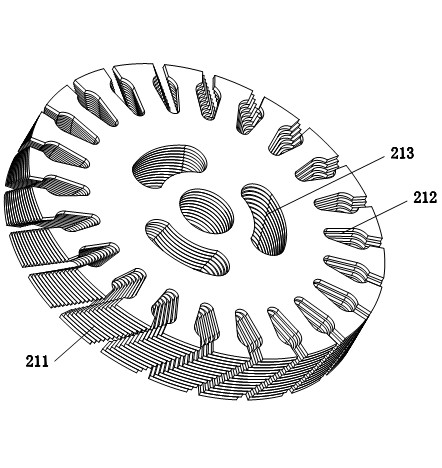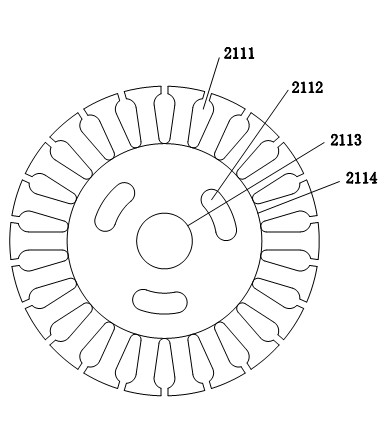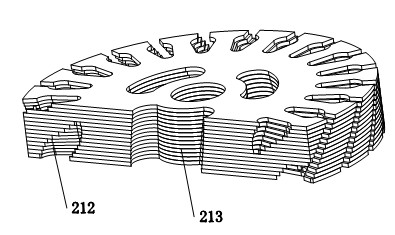Motor rotor
A motor rotor and rotor technology, applied in asynchronous induction motors, electrical components, electromechanical devices, etc., can solve the problems of reduced heat dissipation area, increased rotor inertia, and increased materials, so as to improve starting performance, increase heat dissipation area, Effect of reducing rotor weight
- Summary
- Abstract
- Description
- Claims
- Application Information
AI Technical Summary
Problems solved by technology
Method used
Image
Examples
Embodiment Construction
[0015] The present invention will be further described in detail below in conjunction with the accompanying drawings and embodiments.
[0016] Such as Figures 1 to 5 As shown, a motor rotor includes a rotor shaft 1 and a squirrel cage-shaped rotor 2, wherein the rotor 2 is tightly sleeved on the rotor shaft 1, and the rotor 2 includes an aluminum-injected end ring 22 and an aluminum-injected end ring 22 In the rotor core 21, the rotor core 21 is formed by laminating several rotor punches 211, and several rotor punch slots 2111 are opened on the rotor punch 211, and several rotor punches 211 are stacked Together, the rotor core slot 212 is formed. The rotor core slot 212 runs through the rotor core 21. The aluminum injection end ring 22 is connected by the aluminum filled in the rotor core slot 212 and the aluminum distributed at the end of the rotor core 21. One, the feature of the present invention is that there are several evenly distributed through holes 2112 on the rotor...
PUM
 Login to View More
Login to View More Abstract
Description
Claims
Application Information
 Login to View More
Login to View More - R&D
- Intellectual Property
- Life Sciences
- Materials
- Tech Scout
- Unparalleled Data Quality
- Higher Quality Content
- 60% Fewer Hallucinations
Browse by: Latest US Patents, China's latest patents, Technical Efficacy Thesaurus, Application Domain, Technology Topic, Popular Technical Reports.
© 2025 PatSnap. All rights reserved.Legal|Privacy policy|Modern Slavery Act Transparency Statement|Sitemap|About US| Contact US: help@patsnap.com



